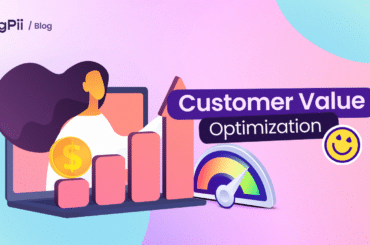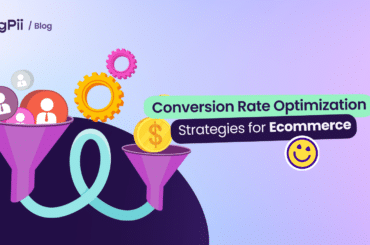As I was working on this article, I did a quick Google search of the term “Customer Journey.”
And guess what I found?

Yes, 3.8 billion results!
This goes on to show how popular the topic of customer journey is. And if you are a marketer or a decision maker at the company you are at, you can’t afford not to know about the journey of your customers.
Ensuring that your customer journey is smooth is as important as, let’s say, creating an ICP or Buyer Persona.
I mean you can’t improve customer experience if you don’t really know the brand touchpoints that your customers go through before making a purchase.
Mapping the customer journey also helps marketers gain insights into the customer pain points. With these insights at their fingertips, marketers can optimize and personalize customer experiences – and this is something that can definitely boost conversions.
Now, that you have an idea of how important it is to map customer journeys, now let’s take a deep dive into this topic.
What’s A Customer Journey?
Every customer, before they purchase your product or service, they embark on a journey first. And that journey is what is known as the customer journey.
So, a customer journey is a representation of each and every touch point that customers have with your brand.
It helps you understand your customers’ experiences with your brand messaging apps, live chat, emails, social media, phone calls, and any other channel they may use.
One important touch point in the customer journey is the in-app chat feature, which enables direct communication between customers and businesses.
For instance, by integrating the Sceyt in-app chat API into your product or service, you can enhance the customer experience by providing real-time support.
A good customer journey map includes the following elements:
- Actors
Think of the actor as the hero in a movie, he’s the main character that you follow mapping all his moves, feeling, thoughts, etc.
- Scenarios
This is the experience that you map, what are you trying to create a map for? I, later on, give an example of a “Music Sharing” scenario by Spotify.
- Phases
These are the steps that you map your user taking that start with the first interaction with your app or website and end up with the desired action that you had in mind.
- Actions
These as the name implies are the actions that your actor takes in your customer journey map, from opening your app to browsing, etc.
- Opportunities
This is the part where everything links together, your team now has to bunker down and figure out.
Now that you know the key building blocks of a customer journey map, it’s time to see the most popular form of customer journey mapping, which is a graphical representation:
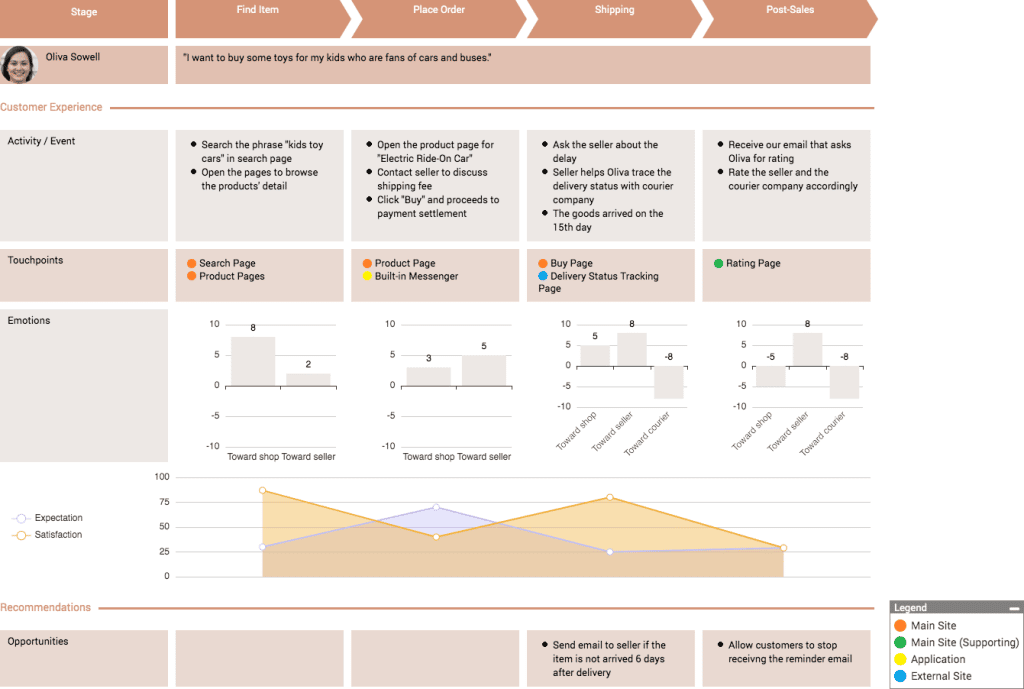
The above image shows the graphical representation of Olivia Sowell’s customer journey map. By looking at the above map, you can easily follow the brand touchpoints that she had before finally making a purchase.
Customer Journey Map vs. Marketing Funnel
Customer journey maps and Marketing funnels appear to be similar in what they try to achieve which is mapping customers’ touch points and making it easier for marketing teams to know what makes customers convert more.
Here, let me give you an example.
If you look at a marketing funnel you’d see that it covers everything from the moment your customer heard about you till he became a loyal fan.
You can see that in an AAARRR or an AIDA or any other marketing funnel you refer to.
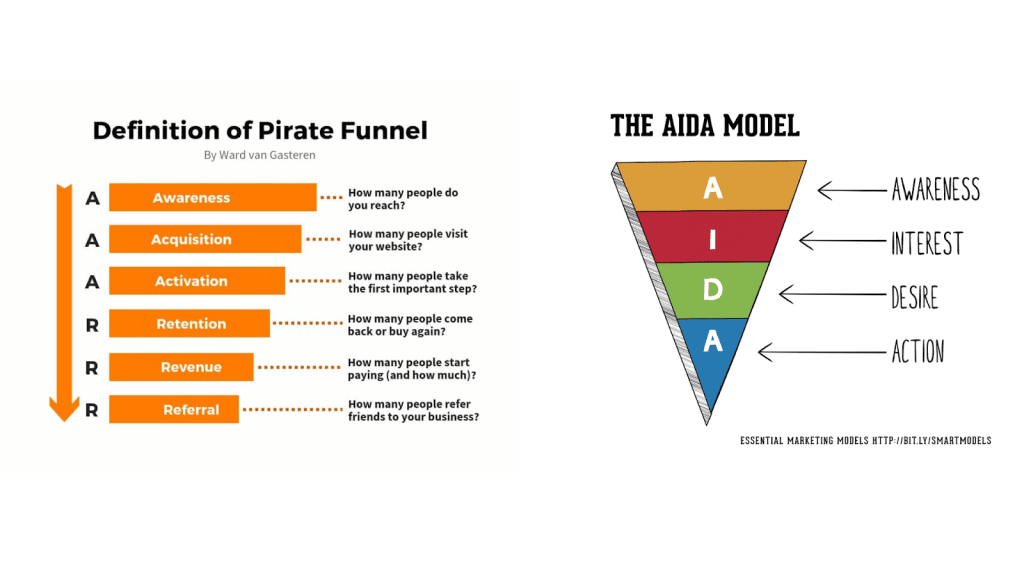
And these are really important for marketing teams because simply you need to have a funnel that you direct your customers through to know things like:
- Where do they fall off?
- What’s the average conversion rate of your business?
- How can we make the process more seamless?
But when you look at customer journey maps you’d find that they cover scenarios that are much more specific and niche.
Granted not all customer journey maps are specific, and some of them are as general as a marketing funnel, but you usually have multiple scenarios that you map.
Like Spotify’s music share, for example, this scenario gives you a map of what happens when you’re sharing music with a friend, it doesn’t go into how did the customer find you or any of that.
And customer journey maps aren’t just important for your marketing team, they’re as equally important to your developers and your product team.
Everyone in the company should be referring to the customer maps as they move on with development or creating roadmaps and plans for the future.
Types of Customer Journey Maps
According to Kerry Bodine there are four types of customer journey maps, these are:
- Current state
- Day in the life
- Future state
- Blueprint
With each one focuing on one aspect of what your actor (customer) will do in the next stage.
- Current state
The current stage maps focus and visualize what your customers do, feel and think about when interacting with your business today or at the moment.
Their aim is to drive improvements to your customers’ experience, and they’re the most common maps when it comes to customer journey maps.
- Day in the life
These journey maps also focus on and visualize what customers do, think, and feel today.
But they take a wider view by examining everything that customers do within a specific area of focus
- .Future state
These maps focus on what your customer do, feel and think as they’ll interact with your company some time in the future.
- Blueprint
These maps are designed to be used as an extension of an existing customer journey map or a future state map, they’re designed to help you uncover unmet customer needs so you can focus on them.
Real Life Customer Journey Map Examples
Since a customer journey is an artifact, you have to know that it can come in different forms. Some customer journey maps I have seen were created using GDoc, a word file, plain texts or images.
In this section, we’re going to look at some customer journey map examples from brands you already know:
Spotify Customer Journey Map Teardown
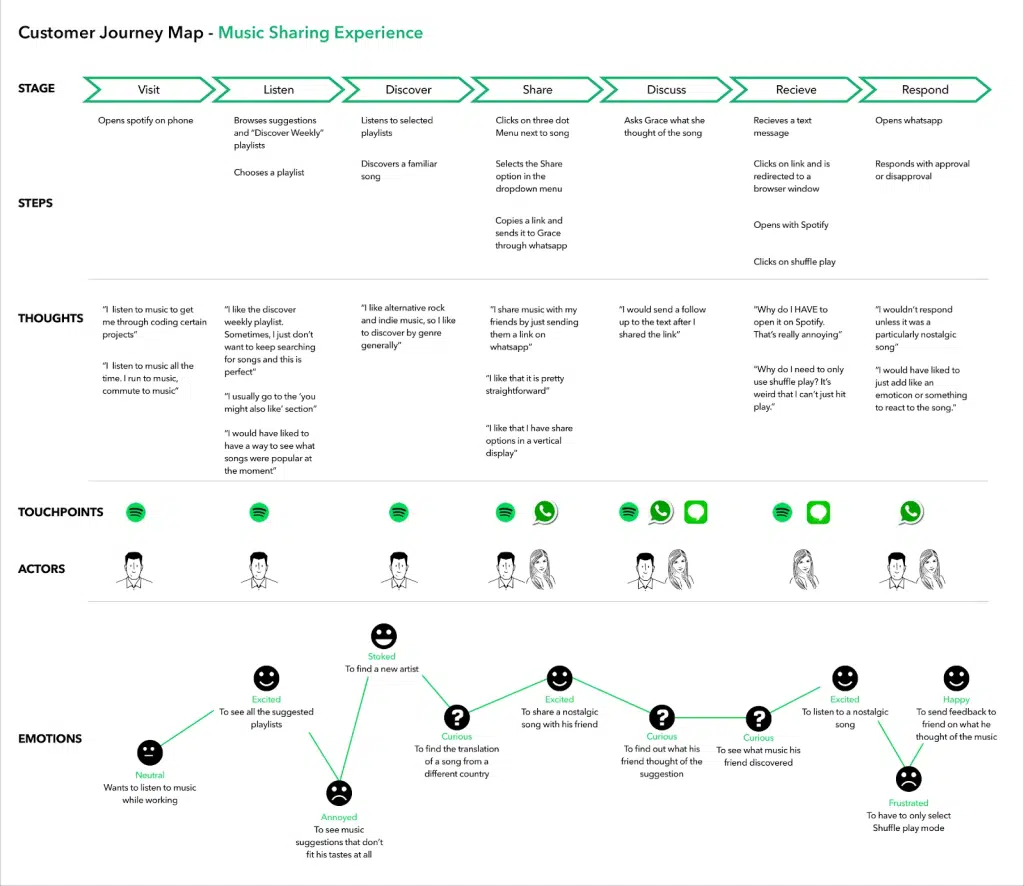
Spotify visualized a very specific use case which is the music sharing experience.
This is very important because you don’t want to have just 1 customer journey map and call it a day.
No, you have multiple touchpoints and use cases that your customer can go through and you can’t just make 1 map for all the experiences that your customer has with you.
So as you can see, Spotify divided its funnel into 7 different stages because that’s how they see users use their product.
This takes me to another point which is your map needs to be fluid and adaptive at all times.
You can’t create a map once and call it a day and keep using it without updating, that would be counterproductive.
Your map needs to adapt to what your users do when they interact with you, on your app, website, or wherever they interacted with you.
So It all starts with the Spotify app which they interact with on their phone, and you see on the left you have a column of things that they track on their map.
- Stage
- Steps
- Thoughts
- Touchpoints
- Actors
- Emotions
You can customize your map to your needs and how it fits you the best so you can add more things to your maps that would help you create a more immersive map.
At the beginning of the blog, I gave an example of the AAARRR funnel as steps to track your customer.
Spotify is using a similar approach but with different naming conventions according to the steps that they see their users take from start to finish.
So in the steps row, we have the following steps:
- Visit
- Listen
- Discover
- Share
- Discuss
- Recieve
- Respond
As you can see each step starts with the action that the user took, which in step one is opening the Spotify app on their phone.
The thoughts behind the action that led them to open the Spotify app.
The touch points which is of course the app, but in later stages, there are more touch points that get introduced to the mix
The actors might be one or multiple people, as we can see from the first 3 steps we can see that the actor is the customer listening to the music and then later on sharing it.
And lastly their emotions at this point in time where they’re listening to the or sharing it.
As you can see Spotify map every possible scenario to make the map as relatable to real life as possible.
So what can you learn from this Spotify customer journey?
- Customize your map to your specific needs
This one is kind of a no-brainer but some people see online maps and decide to use them to map their customer journey maps which is wrong!
While yes you can draw inspiration from other people’s maps you need to have your own unique map that fulfills your needs!
- Map every touchpoint and interaction in your customer’s journey
You need to know where your customers came from, what are the important touchpoints that lead to the actions, and who the actors are.
Answer these questions by simply observing the customer or doing JTBD interviews to get to the bottom of it.
Customer Journey Map Example #2: LEGO

This is also a popular example of a customer journey map developed by lego.
As you can see they divided their customer experience into 3 major sections, Before, After & During.
Customer Journey Map Example #3: TurboTax
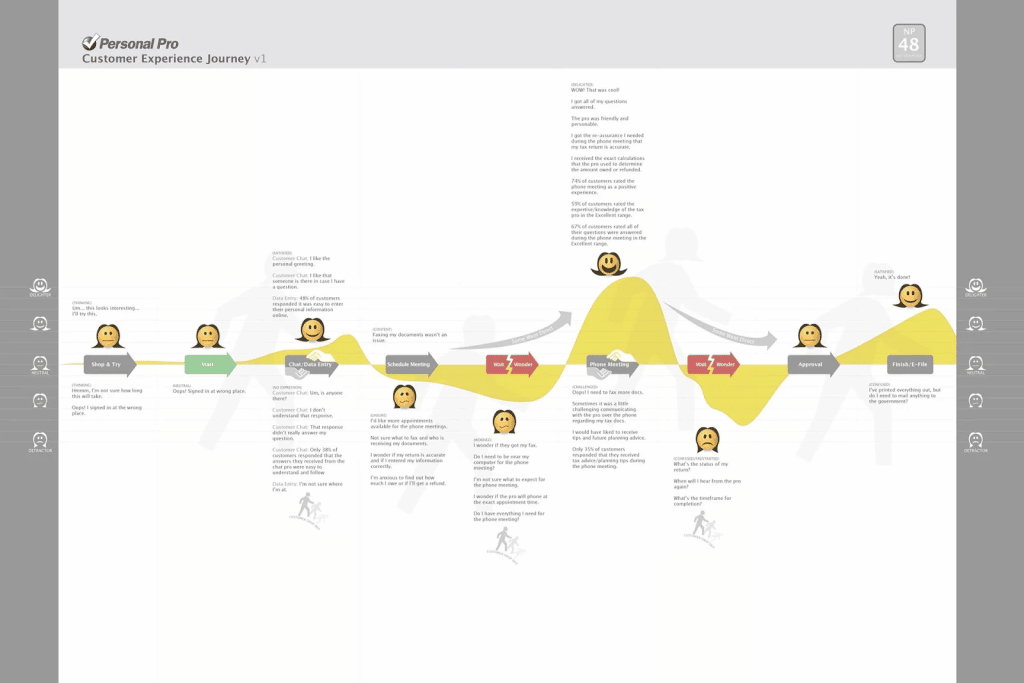
Customer Journey Map Example #4: UXPRESSIA
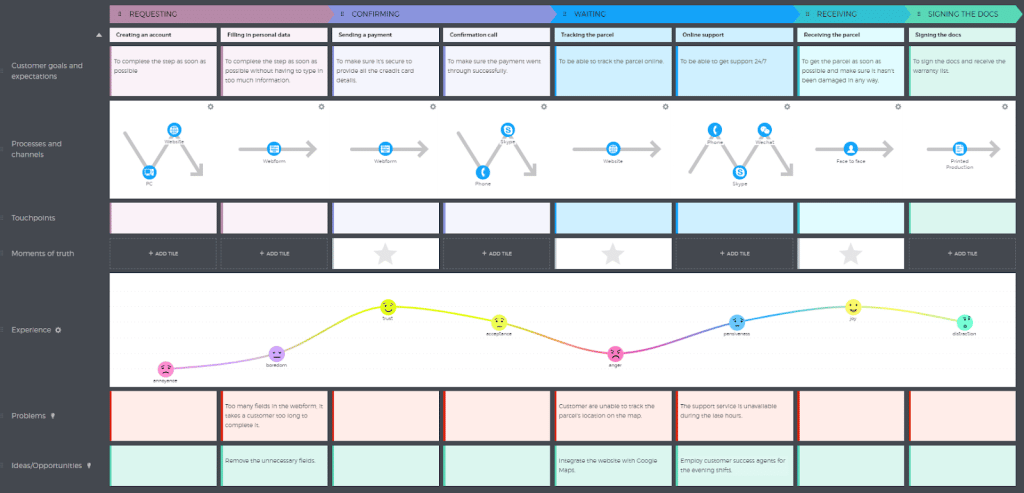
The list of examples goes on and on, the only thing is you need to look at as many examples as you can to help yourself create the most fitting customer journey map for your product or service you can.
How To Map Customer Journey Using JTBD?
We’ve briefly mentioned JTBD or Jobs To Be Done interviews as a way to help you map your customer journey, but how exactly do you do that?
Well, the 1st step to that is to know who’s a good candidate for interviewing, you can’t interview every customer.
The interviewee needs to have bought your product or service in the last couple of weeks, you need that because you need her to have a fresh memory of her purchase.
In simple terms here’s what you need to do:
- Conduct 5-10 Interviews with satisfied customers.
- Dig deep into what made your customer take actions.
- Draw a diagram that helps you map out the customer journey (more on this below).
- Validate the interview insights you gathered using surveys.
So, as you conduct your interviews, you need to draw a diagram that maps out the customer journey. Fortunately, the JTBD framework already have a similar diagram:

As you can see from the above image, the diagram indicates the first time that the customer thought of the product up to the point they ended up making a purchase.
As you interview the customer, you want to capture all those moments highlighted in that diagram above. That will give you a better understanding of the journey that the customers took to buy your product.
Here are some of the questions you can ask to better understand the touchpoints that your customers had with your brand:
- “When did you buy this product or use our services?”
- “When was the first time you thought about buying this product?”
- “What was going on with your life when you thought about buying that product?”
- “Who did you talk to about buying this product?”
- “What were your thoughts/needs that led you to buy this product?”
- “What was your search process like?”
- “What was the second event that made you take the purchase decision?”
The idea here is to capture every moment of your customer journey as if you were filming a documentary.
Make sure you ask some follow up questions so that you don’t get top of mind answers. Here is a good example of a JTBD done interview conducted by our CEO, Khalid Saleh:
Using this mockup interview as a template you can start creating your own customer journey interview, if you need a reference to a customer journey map take a look at the examples we gave above.
How Important Is It To Map The Entire Customer Journey?
It’s very important, in simple terms you need to map out your entire customer journey from start to finish.
As you saw in my Spotify example they mapped out 1 use case of using their product, one specific use case scenario.
Imagine the number of use cases they have for all the scenarios they have for customers using their product.
Usually, customers go through 2 events, the first event is when someone recognizes that they have a particular need, and then they go into passive search.
Then there’s the 2nd event where they’re in active search and trying to find a solution to their issue and will buy it once they know it.
Think of these 2 events as the map, wouldn’t you want to map it completely? Of course, you would.
Nothing tells the story better than your customer pinpointing where, why and what influenced their buying decision.
Conclusion
Customer journey maps are super important for any business, they help you make the most out of your marketing activities if implemented correctly.
We’ve given examples and talked about the process but the most important thing that we didn’t cover here is that you need to get your hands into the mix.
You need to do these kinds of things yourself to learn, no amount of reading would get you where you want to go.


